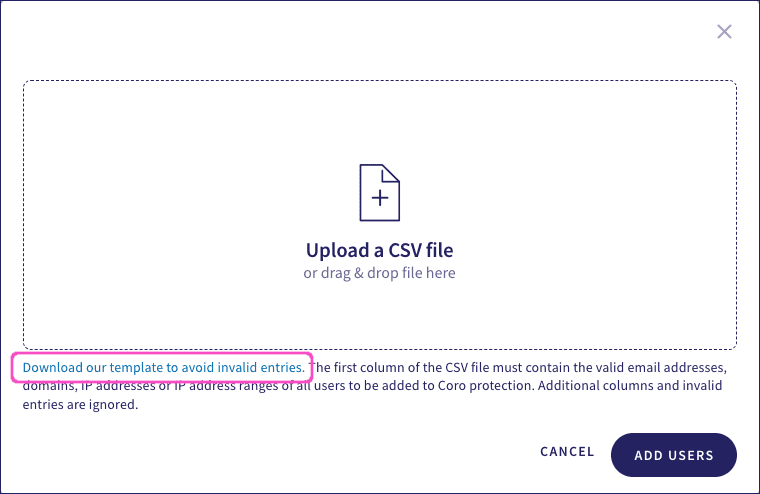Allow or block email senders
An allowlist enables admin users to declare known safe email sender addresses, domains, IP addresses, or IP ranges that Coro can check if an Email Security event occurs. For instance, if an email is flagged by Coro's detection mechanisms as containing spam, potentially malicious content, or a possible phishing attack, Coro continues to allow the email if the sender is listed in the allowlist (and the sender is genuine).
A blocklist lists known bad senders, domains, or IP addresses/ranges where, regardless of content or authentication status, corresponding emails are blocked from being received by the named recipients. Coro raises tickets identifying the blocked event.
Allowlists and blocklists in Coro are workspace-specific and configured by admin users. When scanning emails for threats, Coro checks the lists defined in the current workspace (and, for MSP-managed workspaces, also from the parent workspace and global allowlists and blocklists).
Important
Coro uses two distinct types of global allowlists and blocklists:
- Coro internal allowlists and blocklists : Maintained by Coro and automatically applied to the current workspace, and for MSP-managed workspaces, to the channel workspace and all descendant workspaces. This list is based on continuous research and security observations and is not user accessible.
- MSP global allowlists and blocklists : Available to Managed Service Provider (MSP) admin users with sufficient permissions to view and manage rules across channel and descendant workspaces. For more information, see Global allowlists and blocklists .
Checking allowlisted emails for sender verification
To ensure the integrity of emails, Coro continues to check for indications of suspicious activity even where the sender appears in the allowlist. This helps prevent spoofed identities bypassing Coro's standard detection mechanisms.
Important
This applies only if the allowlisting is by sender email address or domain. Coro treats emails received from an allowlisted IP address, or from within an allowlisted IP address range, as fully trusted.
This can particularly affect internal email where the sender is assumed to be safe by virtue of originating from within the same organization. When a customer signs up to Coro, Coro automatically allowlists a customer's own domains - negating the need for full threat scanning on internal email traffic. However, if an email contains a sender identity spoofed to appear as internal, the recipient might assume the email to be safe when it is not.
To address this, Coro applies certain checks to all emails, internal and external. If the email is from an allowlisted email address or domain, Coro checks the email message headers for confirmation of verified sender authentication. If this check fails, Coro performs a full scan of the email to determine the risk. Therefore, Coro might still block or quarantine an email (or have warnings added, depending on your workspace settings) even though the email appears to be from an allowlisted source.
If you find that allowlisted and confirmed safe emails continue to trigger Coro's detection mechanisms, make sure any incoming or outgoing gateways used for your email domain are properly configured and do not cause Sender Policy Framework (SPF) failures. If you are satisfied that the sending server is trusted and properly configured, consider allowlisting by IP address or IP address range.
Viewing allowlists and blocklists
To view and update the Email Security allowlist and blocklist:
- Go to the Email Security configuration page .
-
Select the
Allow/Block
tab:
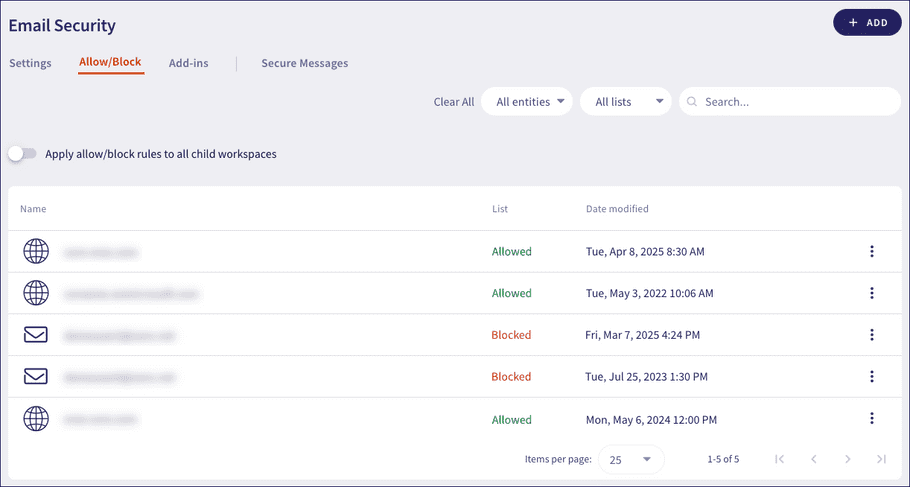
The Name column displays the sender address or domain, and the List column indicates whether each item belongs to the allowlist or blocklist.
Select the All entities dropdown to filter the list by Email, Domain, IP, or IP range:

Select the All lists dropdown to filter the list by Allowlist or Blocklist:

Use the Search box to filter the Name column using a free text search:

Cascading allowlist and blocklist rules to child workspaces
Coro provides the ability for Managed Service Providers (MSPs) and partners to apply allowlist and blocklist rules defined in a parent ("Channel") workspace to all connected child workspaces. To enable this feature, use the Apply allow/block rules to all child workspaces toggle:

note
This toggle appears only for parent ("Channel") workspaces and applies only to the immediate child workspaces.
When enabled, a child workspace inherits ONLY the allowlist and blocklist rules from its parent workspace, combining them with any unique rules defined already within itself. A child workspace does not inherit the rules from any workspace above its own parent (in other words, from a grandparent workspace).
Additionally, when a child workspace itself becomes a parent (through Coro's approach to providing flexible workspace hierarchies), it passes on only those allowlist and blocklist rules defined within it, and none of the rules it inherited from a parent.
Adding entries
Coro enables you to add email addresses, domains, and IP addresses/ranges to the allowlist or blocklist through the following methods:
From Email Security tickets
Coro raises Email Security tickets in response to events such as phishing and malware detection. For protected users, these tickets are typically remediated automatically by Coro - in that the suspicious email message is deleted, quarantined, or delivered with a warning notice (depending on the event type and your selected security mode) and the ticket is closed.
An admin user can view these tickets and make decisions as to whether to add the sender to the allowlist or blocklist.
To do this, open the Ticket Log and review your Email Security tickets. Each ticket involving a protected user includes an ACTIONS button, which provides actions applicable to that ticket type:
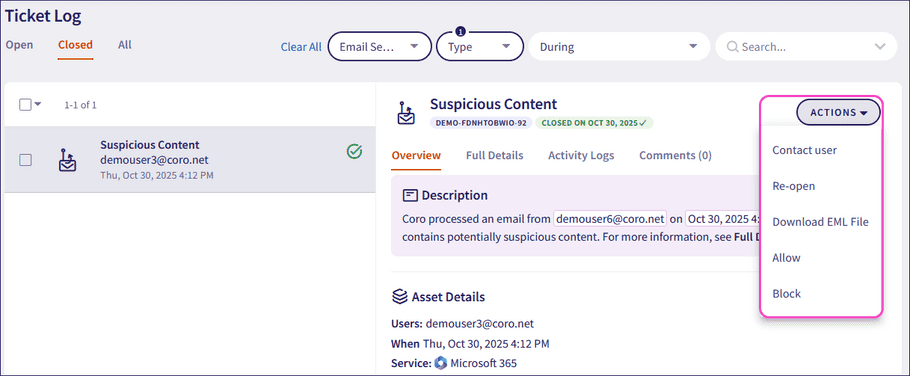
To add the sender to the allowlist, select Allow. Or, for the blocklist, select Block. Coro presents a dialog offering options for each list.
Coro adapts the allow or block options based on a combination of the ticket type and your Email Security settings. For example, if the email contains suspected phishing and you selected a security mode of Quarantine, Coro quarantines the email. As a result, your allow options include the ability to restore the email as well as affect future remediation by adding the sender to the allowlist. However, if the email contains malware, Coro deletes the email automatically and the allow choices are then limited to adding the sender's identity to the allowlist for future remediation decisions only.
Equally, for block options, Coro present choices that take into account remediation that has already taken place. You can only act on the email that triggered the ticket if it has not already been deleted.
This is also true where you have configured threat detection to warn recipients only. The email is already delivered to recipients so the Allow this email or Block this email options are disabled.
note
For a complete list of all Email Security ticket types and the available options in each case, see Ticket types for Email Security.
The following Allow choices represent an example where the email is in quarantine and therefore recoverable:

Choose from:
- Allow this email only : Allow the quarantined email that triggered this ticket to reach its recipients, but DO NOT add the sender's identity to the allowlist. Future emails from this or any other sender in the same domain can still trigger a ticket in Coro.
- Allow this email and add the sender's domain to the allowlist : Allow the email, and instruct Coro to add the sender's domain to the allowlist. Future emails from any senders in this same domain continue to be received by all named recipients.
- Allow this email and add the sender's email address to the allowlist : Allow the email, and instruct Coro to add the sender's email address to the allowlist. Future emails from this specific sender continue to be received by all named recipients.
-
Allow this email and add the sender's IP address to the allowlist
: Allow the email, and instruct Coro to add the sender's IP address to the allowlist. Future emails from this specific IP address continue to be received by all named recipients.
note
This option is disabled if Coro cannot determine the IP address from the sender's identity.
Select CONFIRM to proceed.
In the same scenario, the following Block choices are available:
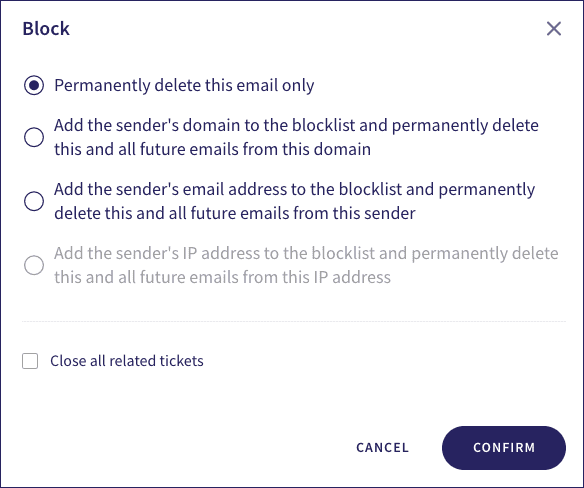
Choose from:
- Permanently delete this email only : Permanently delete the email that triggered this ticket, but DO NOT add the sender's domain or email address to the blocklist. Future emails from this or any other sender in the same domain can still trigger a ticket in Coro.
- Add the sender's domain to the blocklist and permanently delete this and all future emails from this domain : Instruct Coro to add the sender's domain to the blocklist, and permanently delete this and all future emails that originate from any sender in the same domain.
- Add the sender's email address to the blocklist and permanently delete this and all future emails from this sender : Instruct Coro to add the sender's email address to the blocklist, and permanently delete this and all future emails that originate from the same email address.
-
Add the sender's IP address to the blocklist and permanently delete this and all future emails from this IP address
: Instruct Coro to add the sender's IP address to the blocklist, and permanently delete this and all future emails that originate from the same IP address.
note
This option is disabled if Coro cannot ascertain the IP address.
Select CONFIRM to proceed.
note
Both dialogs include the option to enable Close all related tickets. This requests Coro to close all related tickets connected to the event.
note
Coro prevents adding well-known email provider domains to the allowlist or blocklist. In this situation, the option to add the entire domain is disabled, although you can still add individual email addresses or IP addresses.
Directly on this page
To add email addresses, domains, or IP addresses and ranges directly into the allowlist or blocklist:
-
Select
ADD
:

-
Select an option:
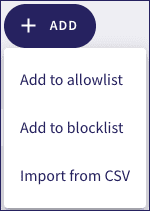
Choose from:
-
Select
Add to allowlist
to add item(s) in the
Add to allowlist
dialog:
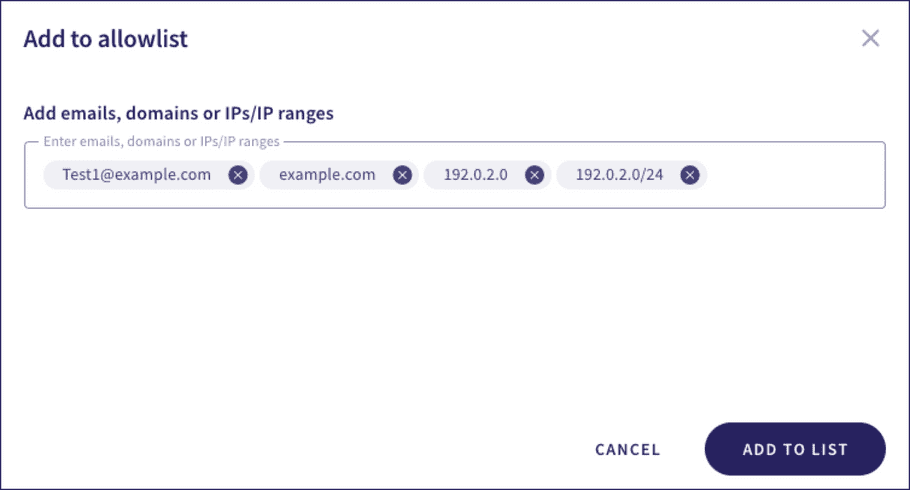
To complete the process, select ADD TO LIST.
-
Select
Add to blocklist
to add item(s) in the
Add to blocklist
dialog:
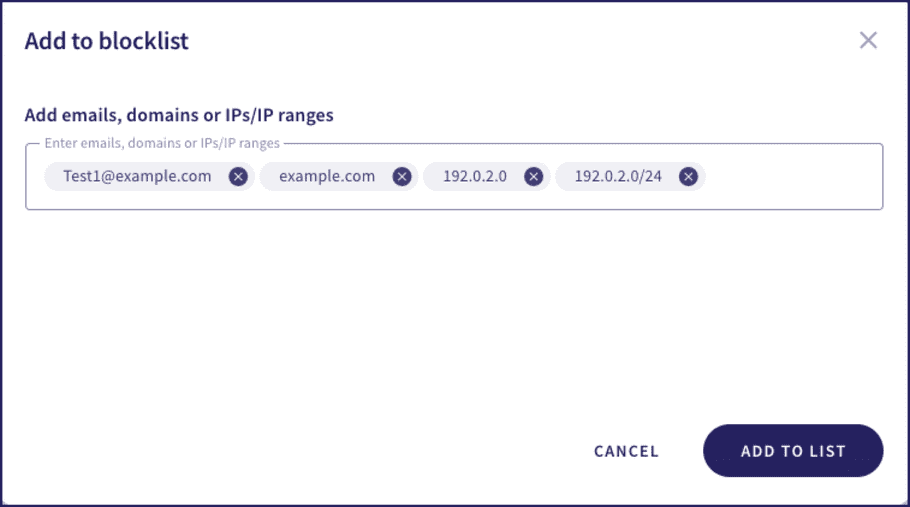
To complete the process, select ADD TO LIST.
-
Select
Import from CSV
to upload a comma-separated value (CSV) file containing your allowlist and/or blocklist data.
note
To learn more about creating a valid CSV file, see In bulk using a CSV file.
Select Upload a CSV file to browse your filesystem, or drag-and-drop a file into the dialog:

To begin the import process, select ADD USERS.
Coro presents a confirmation dialog that the import is now in progress:
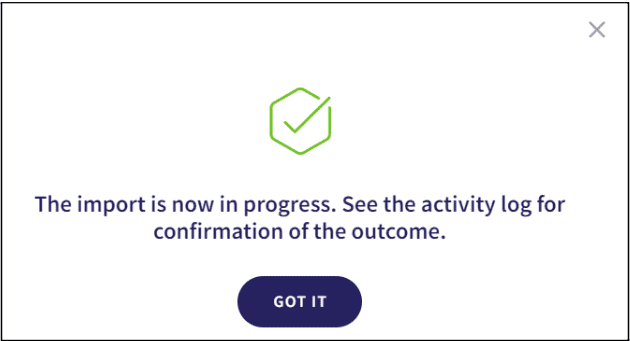
Select GOT IT to continue.
note
After the import process is complete, Coro displays an acknowledgement notice in the Console and places an entry in the Activity Log providing details of the import operation.
-
Select
Add to allowlist
to add item(s) in the
Add to allowlist
dialog:
Your added items are displayed in the Allow/Block list, showing the list they belong to.
In bulk using a CSV file
Coro enables you to add existing email security allowlist and blocklist data by importing a CSV file containing a list of user email addresses with their corresponding list (Allow/Block).
Entries in your CSV file must follow the pattern:
<item>,<policy>
Each entry must be on a separate line, with the following allowed values in each field:
| Field | Description | Allowed values |
|---|---|---|
| <item> | The sender's email address, domain, IP address, or IP address range. | coro1@example.com, example.com, 192.0.2.0 or 192.0.2.0/24 |
| <policy> | Whether to allow or block the item. | Allow or Block |
Files must adhere to the following rules:
- You must specify valid values in both columns. Entries with extra columns or invalid values are ignored.
- The maximum file size is 5 MB.
- A maximum of 100,000 records are permitted.
To facilitate creating a valid CSV file, Coro provides a link to a template in the Upload a CSV file dialog:
